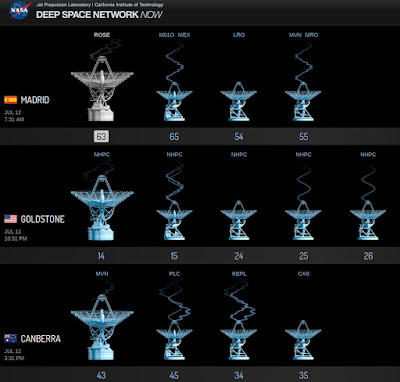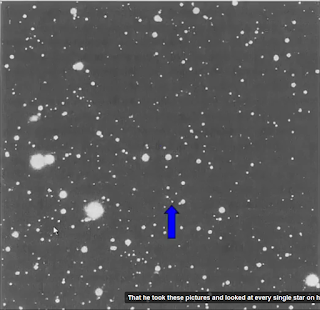New horizons is finally arriving distant Pluto. After almost ten years the flyby is just hours away early on July 14th 2015. The spaceship will neither land on Pluto nor orbit it, but will pass in a mere distance of 11,000KM from its surface giving us unprecedented details and information about it.
I am updating this post frequently both with new photos and images but also with historic information. Don't miss the chance to find Pluto yourself looking at two original images from the Lowell observatory
14/7/2015 - Today is the day
Want to be super updated?
Check NASA-TV and @NASANewHorizons on twitter
As expected NASA released a very good photo just before the PR. While new data will arrive only in about 12 hours after the flyby you can have a small taste with thie fine photo
14/7/2015 - Today is the day
Want to be super updated?
Check NASA-TV and @NASANewHorizons on twitter
As expected NASA released a very good photo just before the PR. While new data will arrive only in about 12 hours after the flyby you can have a small taste with thie fine photo
 |
| Pluto from 76000Km. NASA |
Latest briefing from NASA (short 15-20 min Video, updated daily).
Recent update
13/7/2015 - Find Pluto yourself!!
This is Clyde Tombaugh who discovered Pluto in 1930 when he was 24 years old.
 |
| Clyde Tombaugh. Source: Lowell observatory |
Finding
Pluto was not easy and required to scan thousands of photographic plates
to notice small differences. Although there were no airplanes or
satellite it was a hard task. Today computers are doing it in seconds.
Here are the two original photos. Clyde Tombaugh had a special instrument on which he could flipped two photos. and if he looked carefully enough he would see a difference. Most photos has no difference and even if they had, most of them were specks of dust. But eventually one was a new planet. You can try for yourself using the following two photos. Where is Pluto? (Click on the photo to see it bigger and easily change to the second photo. Try go back and forth between the two). Answers at the end of the article but do try to find yourself!
 |
| Where is Pluto 1 (Lowell Observatory) |
 | |
|
12/7/2015 - Why Pluto is not a planet anymore
The decision to move Pluto out of the planet's list is because several reasons:
1) Its orbits is very elongated and inclined to the ecliptic
2) There are many small bodies like it in the Kuiper Belt
3) He is not big enough and is more to be considered as a binary system together with Charon
However the IAU (International Astronomical Union) had some hard time to define the exact rules in its 2006 conference. For further reading you can look at my review of Mike Brown's "How I killed Pluto" book.
The decision to move Pluto out of the planet's list is because several reasons:
1) Its orbits is very elongated and inclined to the ecliptic
2) There are many small bodies like it in the Kuiper Belt
3) He is not big enough and is more to be considered as a binary system together with Charon
However the IAU (International Astronomical Union) had some hard time to define the exact rules in its 2006 conference. For further reading you can look at my review of Mike Brown's "How I killed Pluto" book.
13/7/2015 - Chasms on Charon
The newest photo of Charon is very interesting. A possible impact craters and a huge chasm relatively larger and deeper than the grand canyon.
 |
| כארון 11/7/2015 - 4 מיליון קילומטטר. נאסא |
What happens during the flyby?
The following info-graphic says it all. Many measurements with all the instruments on board. Just before the flyby a short transmission of the latest photos to Earth, probably for the PR section, and then 4 to 6 intensive hours of work, and only at the end a transmission of just a fraction of the data is planned. Want to see more? Check the eyes on NASA site
.
11/7/2015
This 6Million KM photo of Pluto shows interesting feature. What is the Polygon?.
 |
| Pluto from 6 Million KM. NASA |
Here is more or less the same photo but from 4 Million km.
 |
| Pluto from 4 Million KM. NASA |
 |
| Pluto and Charon. NASA |
Here is an example of how demanding is the communicating task. The entire NASA's Goldstone station is communicating with New-Horizons. check yourself in DSN now. It changes during the day, but that is a good example.
 |
| All antennas at Goldstone are pointing toward New-Horizons |
9/7/2015 - The heart of Pluto
We love these photos. We can imagine things, and this shape is called the heart of Pluto. does it look like a heart? Not really, but our mind tends to look or familiar features so even this approximation is enough. The "Heart" length is about 2000km and is probably new layers of frost gases such as Methane. The dark feature left to the heart is called "The whale".
 |
| Pluto's heart. NASA |
Would you think that it is a hear if you saw this photo first? I am not sure
 |
| Pluto's heart. NASA |
The superb space blog - Universe Today gave a list of all not required things in the spaceship. usually objects to give some emotional aspect to the mission. Here is the summary from UT site (with permission)
- Some of the ashes of Clyde Tombaugh making him the human that reached the further away from earth,
- A CD with 430,00 names of people who registered at NASA site. I am not one of them, but this has become a routine so check out and list your name in future missions.
- Another CD with images of the entire mission's members.
- A quarter from Florida. If ET will need to call home.
- A flag of Maryland
- Two flags of the USA
- A small piece of Spaceship 1
- A stamp from 1991 with the caption: Pluto - not researched yet
The spaceship itself looks like a big piano. Here are two photos from two different angles
 |
| New Horizons. NASA |
 |
| New Horizons. NASA |
So where is Pluto? You will find it much easier in these photos
 |
| Pluto - the moving dot. Lowell observatory |
 |
| Pluto - the moving dot. Lowell observatory |
